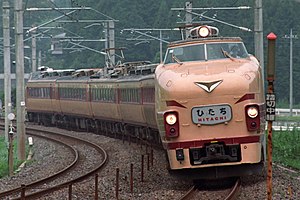| 485 series | |
|---|---|
 An original "bonnet-style" 485 series train on a Joban Line Hitachi service in August 1998 | |
| In service | 1964–2022 |
| Manufacturer | Hitachi, Kawasaki Heavy Industries, Kinki Sharyo, Kisha Seizo, Nippon Sharyo, Tokyu Car Corporation |
| Replaced | KiHa 80 series, KiHa 58 series |
| Constructed | 1964–1987 |
| Entered service | 25 December 1964 |
| Refurbished | 1999–2006 |
| Scrapped | 1985 (481 series) |
| Number built | 1,453 vehicles |
| Number preserved | 6 vehicles and 1 cab end |
| Number scrapped | 1,312 vehicles (the rest of 116 vehicles were converted to 183 series) |
| Successor | 253 series, 683 series, 651 series, E653 series, E751 series, 787 series, 789 series, 781 series |
| Operators | JNR (1964–1987) JR East (1987–2022) JR-West (1987–2011) JR Kyushu (1987–2015) |
| Lines served | Various |
| Specifications | |
| Car body construction | Steel |
| Car length | 20 m (65 ft 7 in) |
| Maximum speed | 120 km/h (75 mph) (Normal) 130 km/h (81 mph) (Kosei Line) 140 km/h (87 mph) (Tsugaru-Kaikyō Line) |
| Traction system | Resistor control |
| Electric system(s) |
|
| Current collector(s) | overhead catenary |
| Bogies | DT32, TR69 |
| Braking system(s) | Dynamic brake, electro-pneumatic brake |
| Safety system(s) | ATS-S, ATS-P, ATC (485-3000 series only), Tobu ATS (Nikkō set only) |
| Track gauge | 1,067 mm (3 ft 6 in) |
The 485 series (485系, 485-kei) (and the earlier 481 and 483 series variants) was a Japanese limited express electric multiple unit (EMU) type introduced in 1964 by Japanese National Railways (JNR), and later operated by the East Japan Railway Company (JR East), West Japan Railway Company (JR-West), and Kyushu Railway Company (JR Kyushu). Approximately 1,500 vehicles were built,[1] although by April 2016, JR East was the only operator still using this type. The last 485 series train was pulled from service on December 11, 2022 when the Resort Yamadori Joyful Train set was retired.